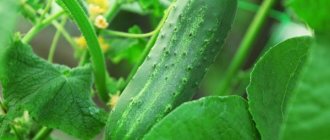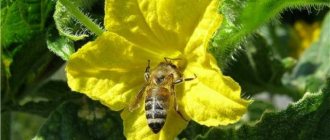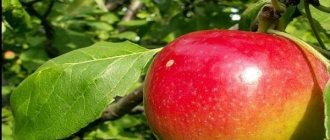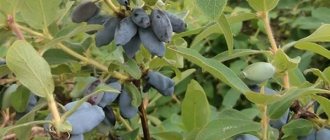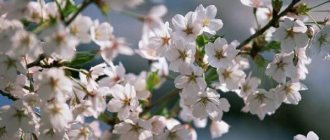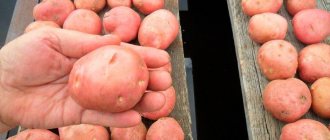Description of the eggplant variety
The variety is mid-ripening: in open ground the fruits ripen 120–140 days after planting . Black Beauty feels comfortable in the garden beds in the southern regions of Russia. The variety is adapted to temperature changes and is resistant to many diseases. However, in the Urals and in the middle zone it is better to grow the crop in greenhouses.
Distinctive features
The characteristics of the variety include an excellent combination of yield indicators and resistance to adverse weather conditions. The black beauty does not stop producing fruits even in bad weather, which makes it different from other representatives of the culture.
Characteristics
The variety forms compact spreading bushes that grow up to 70 cm in height. The stems are covered with fluff, the leaves are small with jagged edges, and have an emerald hue . Throughout the season, the crop is decorated with large light purple flowers.
Black beauty produces large pear-shaped fruits weighing 110–200 g. At the stage of technical maturity, eggplants have a rich dark purple color, which is why the variety got its name.
Ripe fruits reach 20 cm in length, 3.5 cm in diameter, weight - about 900 g. Vegetables are consumed young - they have delicate tasty pulp, thin skin and practically no seeds.
Under comfortable conditions, up to 12 kg of ripe fruits are collected from 1 m2. Each bush ripens up to 4 kg of eggplants of the same shape and size.
How to grow eggplant seedlings?
You can plant eggplants of the Cherny Krasaviets variety with seeds directly into open ground, but the chance of friendly shoots is small, and they will grow for a very long time. The seedling method is much more often used, even in hot, southern regions.
Sowing eggplant seeds for seedlings begins in February. It is recommended to choose seeds from a reputable manufacturer. They may cost a little more, but they will completely pay for themselves. Before planting, it is advisable to soak them in some kind of growth stimulator, but this is not necessary.
How to grow eggplant seedlings
The land for planting is disinfected with boiling water or potassium permanganate. Simply pour it with a weak solution, this will be quite enough. Then it is worth feeding it so that the seeds germinate faster.
Black beauty eggplant seeds are planted in single file to a depth of 2 cm, no more. The distance between individual rows is made up to 5 cm. After planting, the soil is watered (you can use a sprayer to prevent it from being washed away). Now all that remains is to cover with film and wait for the seeds to germinate. This may take 7-14 days depending on the quality of the seeds, the type of processing, and the fertilizers applied to the soil.
After the sprouts appear, the film is removed, the box with the plants is placed in a bright place: balcony, window sill. Sprouts, while they are small, need a long daylight hours - 12 hours. If the day is short, which is natural for February, then you can install an LED, fluorescent or phytolamp above the box with seedlings.
At about 4 weeks you need to plant the seedlings in separate pots. If this is not done, they will stretch out greatly, the roots may get tangled, and in general, this will not do anything good for the sprouts. But a separate pot will provide plenty of space for the root system, it will be able to strengthen, and the culture will become more resilient.
Caring for eggplant seedlings is simple: watering, loosening the soil (with a small spatula or even a pencil so as not to damage the roots), fertilizing. The latter can be done with any fertilizer for eggplants or for seedlings, mineral or organic mixtures.
Our readers liked the articles:
What fertilizers are best to feed eggplant seedlings?
How to grow a variety yourself
To get a bountiful harvest of fruits, it is important to plant the seeds at the end of February or in the first ten days of March and grow the seedlings correctly.
Growing seedlings
To awaken the seeds from hibernation, they are heated in a thermos or hot water. In a gauze bundle, immerse it in warm water for 3–5 minutes, after which it is disinfected in a weak solution of potassium permanganate.
The rules for sowing Black Beauty are no different from cultivating other varieties of eggplant. Planting material is checked for germination, then soaked for 1-2 hours in a growth stimulator. Seeds that have undergone pre-treatment are planted in prepared containers with nutrient soil. After this, the container is covered with film and placed in a well-warmed place.
Attention! The first shoots are expected 2 weeks after sowing.
To obtain high-quality seedlings, select a suitable soil mixture - neutral, airy and saturated with useful substances.
You can buy soil in a store or prepare it yourself from:
- 1 part humus;
- 2 parts of turf land;
- 1 part peat.
A small amount of ash is added to the resulting mixture to increase fertility.
Transfer
When the seedlings reach a height of 20 cm and 5-6 true leaves appear on the stems, the young plants are ready to be transplanted into the ground.
Important! Do not delay replanting, as the grown root system will no longer have enough space in the limited space.
For the Black Beauty, choose a lighted place on the site. Seedlings are planted on prepared soil, maintaining an interval of 40–50 cm between bushes.
On the 10th day after transplantation, the first fertilizing of mineral and organic fertilizers is applied. Like all representatives of the nightshade family, Black Beauty does not tolerate drought, so they moisten the soil as the top layer dries out.
Further care
For the good development of culture, comfortable conditions are created. In addition to the temperature regime, they maintain optimal soil and air humidity (about 60%).
They form bushes as they grow. All leaves and side shoots below the first fork are removed in a timely manner. The tops of the plants are carefully pinched at a height of 30–35 cm to stimulate the development of side shoots.
Small buds and ovaries are removed so that they do not take away the strength of the bushes. For abundant fruiting, leave no more than 10 ovaries.
Features of cultivation and possible difficulties
Eggplants need full daylight - about 12 hours. Its decrease leads to the cessation of ovary formation and fruit formation.
After each watering with warm water, the soil is loosened and weeds are periodically removed. Do not forget about fertilizing the crop: during the formation of flowers (potassium fertilizers), fruits (nitrogen-phosphorus), 2 weeks before harvest (phosphate).
Diseases and pests
The Black Beauty eggplant is resistant to most diseases, but for prevention, plants are treated with disinfectants:
- wood ash solution - against late blight;
- soap solution or “Fitosporin” - against tobacco mosaic;
- fungicidal preparations (“Antrakol” or “Chorus”) - against gray rot;
- "Trichodermin" - against blackleg.
Caring for Black Beauty
To obtain a bountiful harvest, you must adhere to the following recommendations:
- When the first flowers appear, water the bushes with a growth stimulator. This will speed up the formation of fruits.
- When the bushes grow to 40 cm, the top part needs to be pinched. After this, there should be a maximum of 10 eggplants left on the plant.
- Loosen the soil after watering.
- Apply fertilizer 4 times. This should be done 1 month after planting the seedlings, at the stage of bud emergence, when the fruits are forming and a couple of weeks before harvesting.
- Water in the morning and evening. This should be done with warm, settled water.
Important! Cold water should not be used for irrigation, as it provokes fungal diseases. When the soil is moistened during the day, there is a risk of leaf burn.
It is recommended to water the crop only in the morning or evening, using warm water
The Black Beauty variety eggplant is distinguished by its high yield and low maintenance requirements. Nevertheless, for active fruiting, the bushes need to be properly watered and fed. Prevention of the development of diseases and pest attacks is of no small importance. To avoid such problems, you need to follow agrotechnical recommendations and carry out preventive treatments with special preparations.
Harvesting and application
Fruit harvesting begins 30–40 days after flowering . Vegetables do not all ripen at once, so they are picked selectively, checking technical ripeness. It is determined by its appearance: the skin becomes dark in color, the flesh becomes elastic.
The culture is not suitable for long-term storage: the freshness and taste of the fruits remain for up to 2–4 weeks when the vegetables are in the refrigerator or basement.
Eggplants are widely used in cooking. Young fruits are suitable for main courses, larger ones - for homemade preparations, sautés, caviar and other snacks. Overgrown eggplants can be frozen or dried.
What can cause pain and how to fight pests?
The Black Beauty eggplant has average resistance to some diseases, and yet treatment with special substances, or at least folk prevention, will not hurt.
For blackleg you need to use bleach. As for the Colorado potato beetle, either a specialized product or simply manual cleaning can help. At the same time, you need to collect the beetle 2 times a day, only then is this method effective. It is also necessary to use folk or specialized substances against mole crickets, slugs and similar pests.
In order for eggplants to get sick less often, it is best to treat the soil before planting, and the seeds themselves, with potassium permanganate. The lower leaves are torn off from time to time so that they do not come into contact with the ground, and once every 2 weeks the row spacing can be sprinkled with ash.
Reviews from gardeners
Those who have already tried to grow Black Beauty on their plot recommend this variety for cultivation.
Olga, Ulyanovsk region: “I have never tried to grow eggplants - I always thought that this crop was intended for warm climates. One day, a friend recommended the Black Beauty variety. I received a bountiful harvest of shiny, dark-colored fruit, as advertised, with great flavor.”
The Demidovs, Syzran: “My husband and I love to grow new varieties of various crops. Last season, a garden store noticed a beautiful package of seeds with a photo of unusually shaped eggplants. This was the Black Beauty, which we now constantly cultivate and recommend to others.”
Nina Vasilievna, Tambov: “The black beauty grows in my greenhouse and bears its first fruits 2 weeks earlier than in open ground. It has an excellent taste and is indispensable for homemade preparations. I recommend this variety to everyone."
Rules for planting seedlings
Transplantation is a painful procedure for plants, especially from home to open ground.
Important! If the weather is sunny, it is better to transplant seedlings in the evening; if it is cloudy, in the morning.
To minimize the possible negative consequences of transplantation, you should adhere to certain rules:
- A few days before the planned date of transplantation, the seedlings stop being watered, and an hour before planting in open ground, they are spilled with plenty of water so that the earthen ball does not crumble when removed from the planting container. Plants in peat pots are lowered into a prepared hole in the ridge without being removed from the container.
- Remove the plant from the plastic container carefully, holding the plant stem between your index and middle fingers, and with your other hand you need to turn the container over, while pulling the container towards you. After removing the seedlings, holding a lump of earth, quickly place the plant in a heavily moistened hole in the garden bed.
- The time for planting in open ground for the Black Prince eggplant is early to mid-June.
Black handsome. Characteristics of the variety
The fruits of the Black Beauty are elliptical in shape with a dark purple shiny skin and grow up to 13-15 cm in length and 11-12 cm in diameter. The eggplant pulp is cream-colored, tasty and without bitterness. Black beauty is suitable for all types of home cooking - from drying to canning.
A description of the Black Handsome can be seen in a short video:
Black beauty is considered one of the highest-yielding eggplant varieties. From one sq. m with proper care you can harvest about 12 kg of fruit. Accordingly, one bush can produce more than 3 kg per season.
The plant is low, branched, fruits begin to form in the lower part of the plant.

